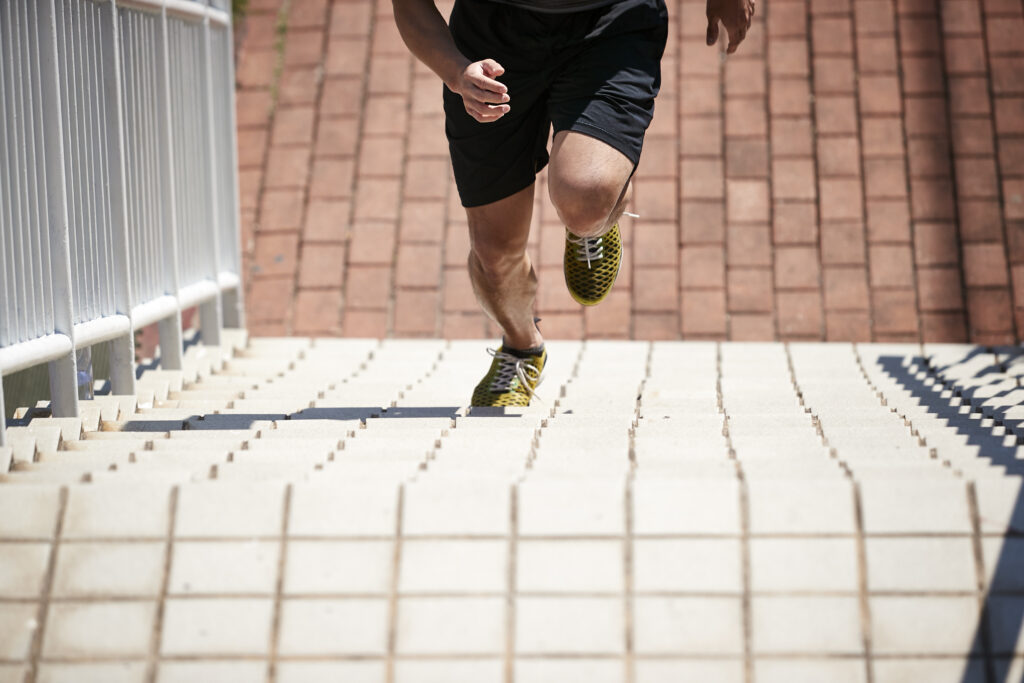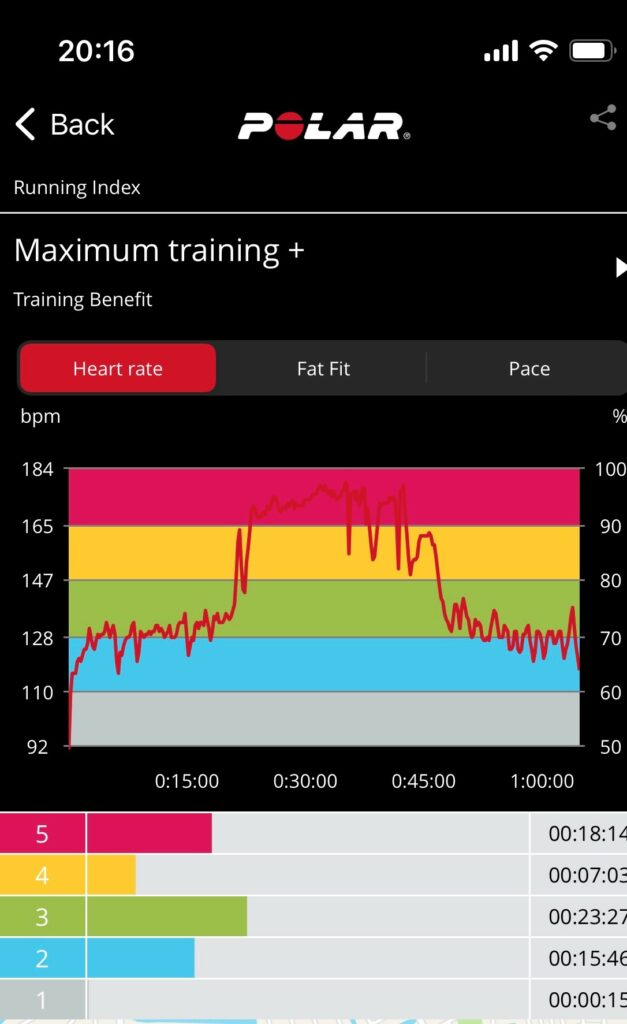
Are you looking for a workout that delivers maximum benefits for your running while requiring the least amount of time? Look no further as the science is clear that HIIT training delivers a powerful punch. These workouts are not for the faint of heart, but I’ve found that using a heart rate monitor can make all the difference.
As a general rule, using a heart rate monitor for HIIT workouts can motivate and optimize your workouts. Tracking your heart rate can ensure you are training in the targeted zones, but it also gives valuable data to help keep you safe. With a little knowledge, it becomes a powerful tool to monitor and enhance fitness by providing instant and reliable feedback.
HIIT training improves fitness and athletic performance in a fraction of the time, but there is a catch. HIIT workouts involve training at near maximum levels which is harder than you may think. Read on for some extra motivation for doing HIIT training and some great tips on how using a heart rate monitor can help you get the most out of them.
Numerous Scientific Health Benefits of High-Intensity Interval (HIIT) Training
Each year there are more and more studies on HIIT training as it has grown in popularity. The benefits abound in both active and sedentary individuals with no apparent disease or health disorder.
HIIT Training is well known for reducing the risk of many of the prevailing chronic health conditions and can even improve some conditions such as diabetes. In addition, HIIT training is good for weight loss, improves mental health, can stop the aging process, improves athletic performance and more.
Some of the well documented health benefits include (see study here).
- Improved mood and decreases feelings of depression and anxiety
- Lower risk of breast cancer
- Lower risk of cardiovascular disease
- Increases metabolic rate and lowers body fat mass
- Reduction in incident of osteoarthritis
- Lower risk of metabolic syndrome
- Helps relief from low back pain
- Improves insulin sensitivity and lower risk of T2D
- Lower risk of colon cancer
- Reduction in falls for older people
- Enhances neuroplasticity (see study here)
- Halts aging at the cellular level (a small study in Cell Metabolism in 2017)
Why runner should incorporate HIIT workouts

In addition to the health benefits noted above, HIIT training has quite a few benefits over moderate and low intensity training. Studies have found some interesting benefits that runners with limited time will find encouraging.
A famous study done in 1996 that led to Tabata workouts shows the clear performance benefits in a shockingly short period of time.
| Workout | Type of Exercise | Length of Workout | Days per week | VO2Max Improvement | Anaerobic Capacity Improvement |
| HIIT training | stationary bike | 4 min total (7-8 sets high-intensity for 20 seconds with 10 second rest between) | 5 | 15% | 28% |
| Moderate intensity Workouts | stationary bike | 60 minutes | 5 | 10% | No improvement |
Another 2017 study found HIIT training for only 4 weeks performed twice a week increased 5K peak speeds and running economy. These are encouraging studies to motivate runners looking to improve performance fitness, endurance, and speed.
The above is not a complete list of all the benefits and studies continue to be done in this field of exercise. From new runners to seasoned athletes, everyone can benefit by performing HIIT training sessions each week.
With all these benefits you will want to get the most from your training and using a heart rate monitor can help you do just that.
Heart rate monitors can help maximize your HIIT workout
HIIT workouts are characterized by short high intensity efforts near maximal effort with periods of rest or low-intensity exercise. Studies and plans all vary the length of the intervals, but all agree the effort should be in the upper limits of our maximum heart rate.
A heart rate monitor can ensure you are training in the right zone. This sounds easy, but there are two pitfalls you can fall into when relying on perceived effort for what you think is high intensity. Over-achievers may do the intervals too hard while those having a hard day may not be working hard enough.
A heart rate monitor will not leave you in doubt as it provides near instant feedback to know if you are in the targeted intensity zone. To utilize a heart rate monitor properly you will need to know your personal max heart rate and exercise at a percentage of this number (see my article here for more HR monitors and running)
Heart Rate Monitors can dial in the right training zone

There is no universal HIIT training workout. Different plans involve different intensity levels for different amounts of time. Knowing your max heart rate is key to find which level you should ideally be training at.
Below are some of the most popular ways of calculating your max heart rate for healthy individuals.
- Traditional MHR = 205 –(.5 x age)
- Updated MHR = 205 –(.5 x Age)
- Field test: Warm up for 10 minutes and perform 3 repeats running hard for 2-3 minutes and then resting 2-3 minutes between runs. With each repeat increase the speed each time. After last repeat check your max heart rate.
*Keep in mind there are many variations of field test. People with heart issues, disease, or any other health issue should not perform this kind of test.
Many of the HIIT studies had participants exercising at or above 90% of their maximum heart rate, but this can vary. According to the American College of Sports Medicine, high-intensity intervals are exercises that you typically perform at 80 to 95% of your maximum heart rate, for anywhere from five seconds to eight minutes
The general rule seems to be that the shorter the high-intensity session, the higher the percentage of max heart rate. For longer hard intervals you should aim for the lower end of the heart rate range. As you continue to use your monitor you will be surprised how your heart rate does not always match what you think it should be (I know I still get surprised).
A heart rate monitor is good for injury prevention

Your maximum heart rate is an important metric as it represents the number of times your heart can beat in a minute during exercise without overexertion. Running too much in the higher zones, especially above 90% can lead to fatigue, burnout, and injury.
Tracking your total time each week in the upper heart rate zone with a monitor can keep you safe. Penn State University recommends not exercising above 90% of your maximum HR for more than 30-40 minute per week.
HITT has some great benefits so it can easy train too hard for too long. HIIT training should not be performed every day and studies conducted were either 3 – 5 times week. As a runner, the total high intensity training done between speed workouts, fartleks, and HIIT training can really add up so a heart rate monitor will be excellent tool to track all your efforts.
Using a Heart Rate Monitor can make the session more fun
While HIIT training sounds appealing because the time spent exercising is a lot less, the intensity is really high. Let’s face it, not all time is created equal. When we enjoy something the time flies by, but when we are in pain, time seems to crawl along.
Using a heart rate monitor to track your heart rate in the high intensity sessions can make the process more enjoyable and the time can fly by. It takes a few seconds for the heart rate to get in the zone and concentrating on keeping it in the zone becomes a game you play against yourself.
It also become fun to see your progress with your heart rate monitor. Some of the best metrics to track with your heart rate monitor is your resting heart rate, heart rate recovery (see my article here for more information on heart rate recovery) and comparing pace or speed at same heart rate over time.
HR Monitor valuable for HIIT target zones for all exercises
I’ve found that when doing a different type of exercise, it is very difficult to judge intensity zones. A heart rate monitor is great for hitting the higher target zone regardless of how familiar you are with exercise.
I recently started using my bike to cross-training and HIIT intervals. I have never used my bike for cardio workout much less a HIIT session, so I had a hard time gauging my heart rate from perceived effort.
Using a heart rate monitor is the best way of quickly adapting any exercise to a HIIT workout. Whether you are doing burpees in a hotel room or biking with your kids around the block, getting a quick HIIT workout in at the appropriate level is easier than ever with a monitor.
Key Takeaways
HIIT training promises a lot of benefits for a short period of time. To get the most out of these difficult workouts and remain safe, a heart rate monitor is a great tool regardless of the type of exercise.
I consider my monitor to be like a personalized coach as it monitors my training and enhances my running performance with reliable feedback. It also makes the hard workouts more enjoyable and provides the extra motivation I make sure I’m working hard enough. I’m sure you will find a monitor just as helpful as I have.
***HIIT is considered safe for most, but no with those with cardiac health issues. Also be sure to consult a physician if you are new to exercise. If you have been sedentary, it is recommended a few weeks of lower and moderate intensity workouts before starting any higher intensity training.